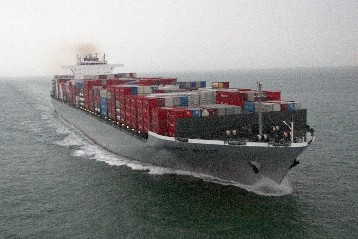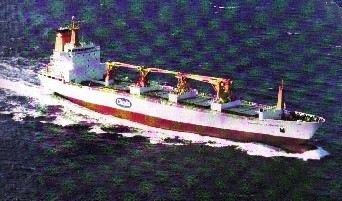
Home page||Ship employment
||
Container refrigeration - Puprpose of dedicated reefer ships
Refrigeration on board ships

Today, a newbuild Panamax containership of 4,600TEU will typically have capacity for 700
reefer plugs, and with a full load will consume 18 tonnes of HFO per day. However, you
cannot just load a container, plug it in and play it like a computer component. Questions on
requirements of the content and the power consumption demanded are just some of the
items that a refrigeration technician must consider.
With a growing global refrigerated trade of 50M tonnes p.a, and with few dedicated reefer
ships on order, growth is going to be seen in the available refrigerated capacity on container
ships. However, increased reefer cargo claims point to a lack of knowledge by both ship and
shore personnel.

Fig: Dedicated reefer ship underway
Purpose of reefer ships
Many of the container ships operating on trade routes where refrigerated
cargoes were carried in conventional refrigerated cargo liners (‘reefer
ships’) have provision for carrying refrigerated containers and have in many
cases replaced the latter.
The ISO containers (usually 20 foot size since with most refrigerated
cargoes 40 foot size would be too heavy) are insulated, and below decks the
end of each hold may be fitted with brine coolers which serve each stack of
containers. Air from the brine coolers is ducted to and from each insulated
container. Connection of each container to the cold air ducts is by means of
an automatic coupling which is remotely controlled and can be engaged
when the container is correctly positioned in the cell guides.
The below decks system described with fully insulated containers means
that heavy insulation of the hold space is unnecessary. On the ships sides,
bulkheads and deckhead about 50 mm of foam insulation with a fire retardent
coating may be fitted and the tank top covered with 75 mm of cork and
bitumastic. If provision is only made for the ship to carry a part load of
under deck refrigerated containers these are generally arranged in the
after holds adjacent to the machinery space.
On deck refrigerated containers are generally serviced by clip-on air
cooled electric motor drive cooling units. The units are plugged into the
ships electrical system by way of suitable deck sockets. Similar water cooled
units have been used for below deck containers on short haul voyages.
Other useful articles :
- Methods of refrigeration
Refrigeration is essentially the removal of heat through
the process of evaporation. We choose to refrigerate
commodities such as fruits and vegetables because we
want to prolong their “practical shelf life” – the time from
harvest until the product loses its commercial value.
More .....
-
Reefer cargo stuffing
it is essential that all products are treated correctly prior
to stuffing. Even though the temperature, ventilation and
humidity are all optimal during the entire voyage, products
will only arrive in perfect condition if the pre-treatment has
been performed correctly. Successful shipping begins at the
product sourcing area.
More .....
-
Growing demand for container refrigeration
On deck refrigerated containers are generally serviced by clip-on air cooled electric motor drive cooling units. The units are plugged into the
ships electrical system by way of suitable deck sockets.
More .....
-
Frozen products packaging requirement
Proper packaging procedures will help protect frozen cargo
during transport. Frozen products do not require air holes in
the top and bottom of the cartons. Air flowing around the load
is sufficient to remove heat that has penetrated the container.
The cartons should be stacked directly on top of each other to
take advantage of their strength in the corners.
More .....
- Packaging & stowage guideline for reefer cargo
Packaging plays an important role when it comes to protecting the cargo. The packaging material must be able
to support a stacking height of up to 2.4 metres (7’10’’).
The material should be able to withstand humidity without
collapsing, and should allow the passage of an adequate
vertical airflow through the cartons in order to maintain the
desired temperature..
More .....
- Choice of packaging for various commodities
Goods should be well stowed within the package,
evenly distributed and properly secured. Items
completely filling the case or carton contribute to
the strength of the whole package. Items which do
not completely fill the package must be cushioned
against shock or vibration.
More .....
- How to keep cargo fresh ?
Proper ventilation of fresh, chilled products is necessary to
remove the heat, carbon dioxide and other gases produced
by the cargo. Heat is removed by continuously circulating
the internal air, whereas carbon dioxide and other gases are
removed by replacing the internal air supply with cooled
fresh air..
More .....
- Loading precautions for refrigerated cargoes
Refrigerated cargoes include meat carcases, carton (packed) meat, fruit, cheese, butter, fish and offal. Ships are specifically designed for their carriage, with separate spaces in holds and ’tween decks, each fitted with suitable insulation and individual control of ventilation. Ordinary general cargoes may be carried in the spaces at other times, the temperature being regulated accordingly for the type of cargo being carried.
More .....
- Role classification societies maintaining seaworthiness of vessels
classification societies publish rules and regulations which are principally concerned with the strength of the ship, the provision of adequate equipment, and the reliability of the machinery .
More .....
- Periodic survey requirement by classification societies
To maintain the assigned class all steel ships are required to be surveyed and examined by the Society’s
surveyors at regular periods.
The major hull items to be examined at these surveys only are discussed
here..
More .....
Machinery system main info pages
Home page||Cooling ||Machinery||Services ||Valves ||Pumps ||Auxiliary Power ||Propeller shaft ||Steering gears ||Ship stabilizers||Refrigeration||Air conditioning ||Deck machinery||Fire protection||Ship employment
||
Home ||
General Cargo Ship.com provide information on cargo ships various machinery systems -handling procedures, on board safety measures and some basic knowledge of cargo ships that might be useful for people working on board and those who working in the terminal. For any remarks please
Contact us
Copyright © 2010-2016 General Cargo Ship.com All rights reserved.
Terms and conditions of use
Read our privacy policy|| Home page||
